 |
||
|
||
| ||
Seagate's share on the hard disc market is extending more and more, partially at the expense of reorganization of Quantum and Maxtor. The company started with a revolutionary disc Cheetah X15 (RPM 15000) and then turned to Barracuda 180 and Barracuda 36ES. But this process involves not only high-efficient SCSI discs but also IDE devices. As you know, Barracuda ATA takes one of the leading places among 7200 RPM discs, and Seagate U5 boasts of a high speed and a low price. But U5 series is not the final one: recently it
was replaced with the Seagate U6 line. At the company's site this
series is often called simply Seagate U. The basic difference of
this line from the previous one is twice extended record density.
Now one side of the disc can contain 20GB! Besides, in the new series
Seagate extended the buffer volume on the discs up to 2 MBytes.
In appearance, the new disc of Seagate doesn't differ from the U5
one (the bottom side is covered with a SeaShield, but we have taken
it off for a photo): 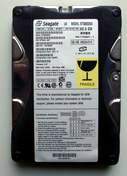  The new Seagate's series is comparable to Fujitsu MPG3AT, Maxtor DiamondMax VL40 and Western Digital WDx00AB. Besides, we have taken the Seagate U5 disc for the tests. Technical characteristics of the competitors:
Notes: 1. Seagate ST315311A for 15 GBytes and Fujitsu MPG3307AT for 30 GBytes are absent in the table. 2. Different companies use different techniques of measuring Average Seek Time. No other explanations why equally named parameters do not correspond to each other are known. The record density is higher because of the increased number of cylinders on a disc (and not at the expense of sectors on a track). This way was taken by Seagate as relatively cheap for extending a disc volume - it's the first time when a 80 GBytes disc uses only two platters. The access time have probably grown (that is why IOMeter results may be worse). But the increased disc volume should positively tell upon the Winbench test. But let's wait and see... The testing technique and test platform completely coincide with the earlier used ones. The competitors in the test are Seagate U5 ST340823A, Fujitsu MPG3204AT, Maxtor DiamondMax VL40 34098H4, Western Digital Caviar WD300AB. Let me start with the ZDLabs Winbench. The graph of linear reading from a disc surface
(the horizontal axis shows percentage of a disc volume):  Comparison with the contestants: 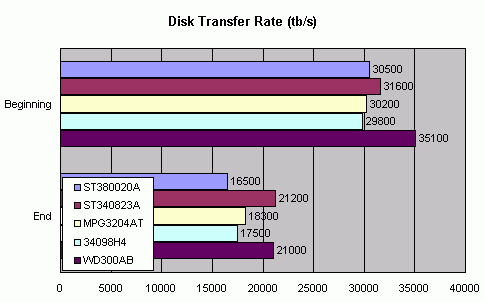 As compared with the U5 model the linear reading
speed has decreased a little bit at the beginning, and the ST380020A
joins to a wide group of storage devices with the highest reading
speed about 30 MBytes/sec. And as for the reading speed at the end
of the disc, the Seagate U6 takes the last place. 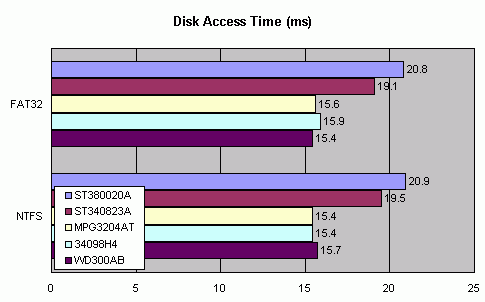 The access time has grown a bit as compared with the U5 series. It should affect the IOMeter test which is very sensitive to this parameter. Comparison with the integer parameter of the Winbench
looks much more interesting: 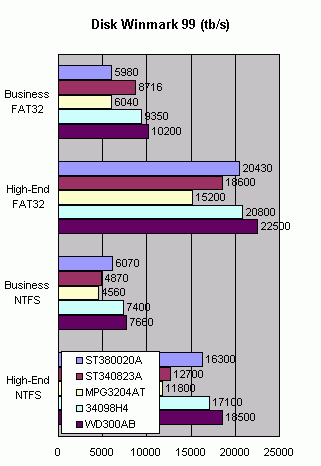 In all tests, apart from the Business with FAT32,
the new Seagate takes a firm third place. As far as the strong fall
in the first group is concerned, the disc seems to have suffered
from its large volume. The FAT32, on the one hand, allows using
hard discs up to 128 GBytes. But on the other hand, FAT itself grows
as the disc volume gets larger. It means that the time of operating
with it also becomes more. Of course, we may increase a cluster
size, but in this case time of operation with small files becomes
higher, and losses of the disc volume grow. Let's look at the size
of one FAT table for a FAT32 partition of 40 GBytes, and at an average
size of losses if it contains 20K files:
We may also compare parameters of the Business
Disk WinMark for a 30 GBytes partition being formatted for the FAT32
with different cluster sizes: 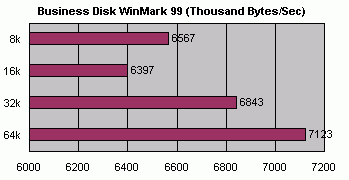 As you can see, the results depend much on a cluster size. Unfortunately, the developers of this test do not give its detailed description. It seems that they use a very simple template, for example, operation with 8 KBytes blocks, 20% random access/80% serial, read only. That is why we should use samples of the same volume. Unfortunately, we had only a 80 GBytes disc, but we hope to test a 40 GBytes model as well in the near future. The High-End Disk WinMark uses templates calculated according to operation of real applications, and at the expense of their wide variety the effect is weaker. NTFS lacks for such problem. For example, 40 and 80 GBytes discs are formatted with the same cluster size of 4 KBytes (it can be changed). The size of the identical table, MFT, is dynamic. It also positively tells upon the situation. Now let's turn to the IOMeter test. As usual, we use three patterns - Server, Database
and Workstation with 5 versions of load (this parameter is marked
on X-line). The vertical axis shows speed in MB/sec.  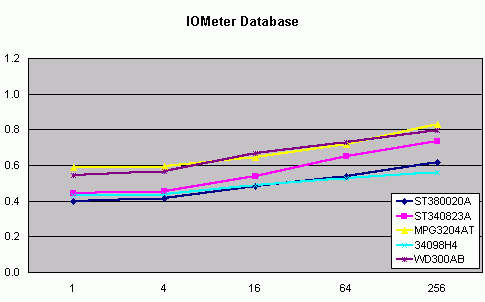 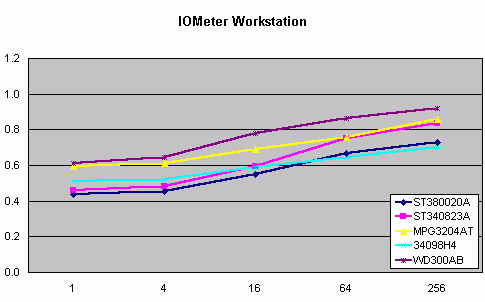 The performance of the Seagate U6 is not great here, first of all, because of the large access time which greatly affects the IOMeter results. The leaders are WD300AB and Fujitsu MPG3204AT due to a small access time. It's interesting that the graphs of the Seagate U6 and Maxtor DiamondMax VL40 are very similar to each other despite different access times. It's obvious that not everything depends on a graph of linear reading and access time: there are other hidden differences. ConclusionThe new disc of the Seagate U6 series is undoubtedly a successful model. Thanks to a high record speed it's the first time when a 40 GBytes disc uses only one platter. Unfortunately, the increased record density affected an access time, but we hope it will be eliminated very soon. An expected low price allows us to assume that
the model will become very popular. High results of the ZDLabs Winbench
place the new generation of Seagate disc into a leading group among
5400 RPM hard discs. Optimization of the internal software makes
the highest contribution into it. The Seagate engineers managed
to lift the performance when working with usual applications under
Windows at the low cost. Low results of the IOMeter shouldn't be
attached importance to since one will hardly use such disc in servers.
At least it can be used in the IDE RAID to build an inexpensive
system with a disc size up to 320 GBytes on one controller! Write a comment below. No registration needed!
|
Platform · Video · Multimedia · Mobile · Other || About us & Privacy policy · Twitter · Facebook Copyright © Byrds Research & Publishing, Ltd., 1997–2011. All rights reserved. |